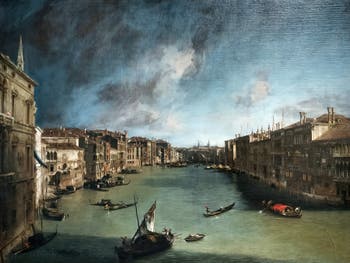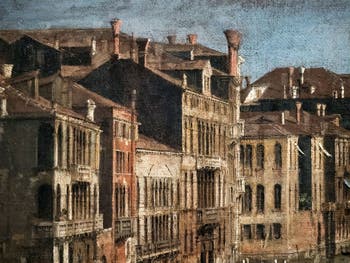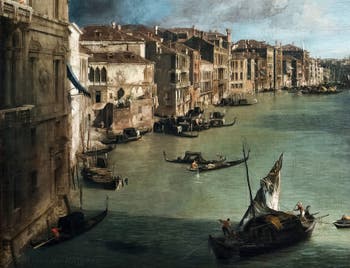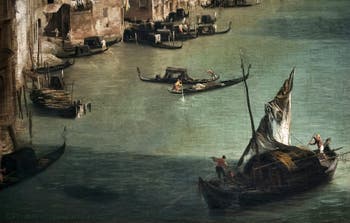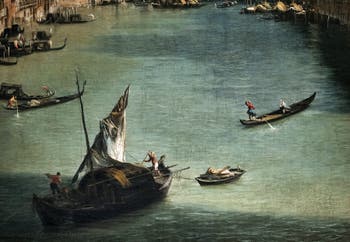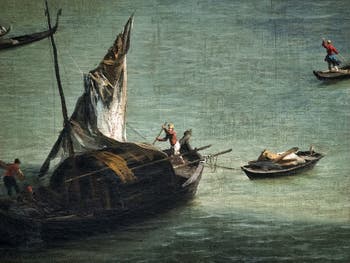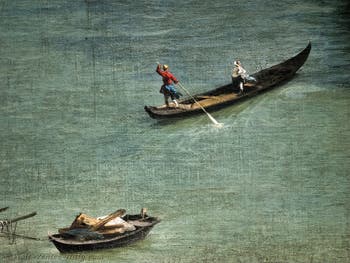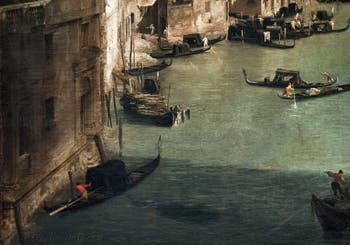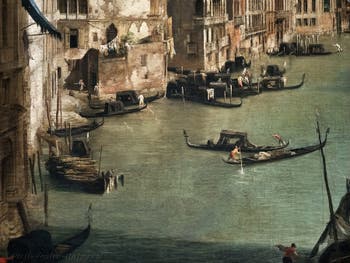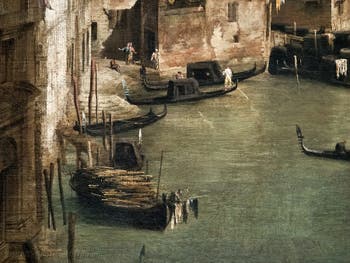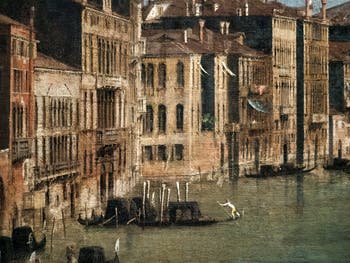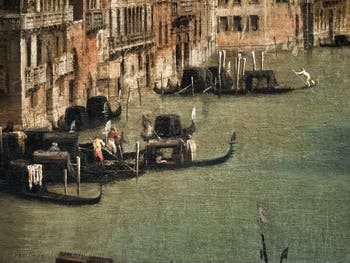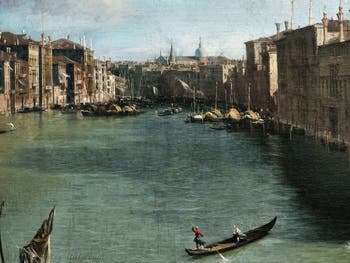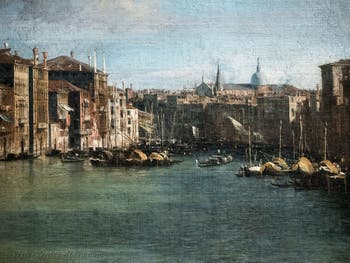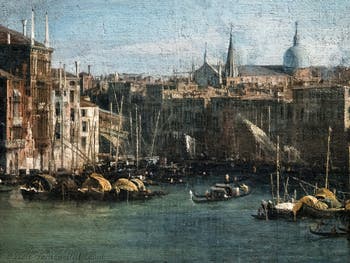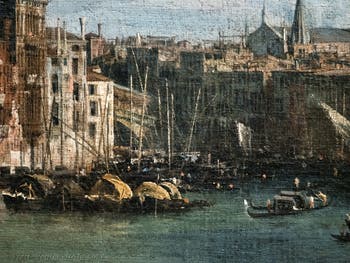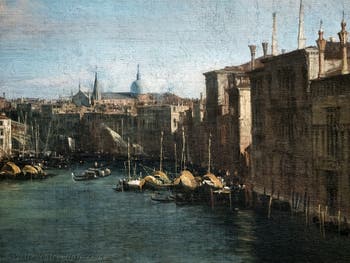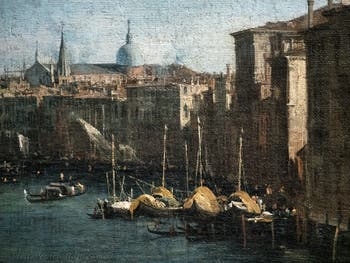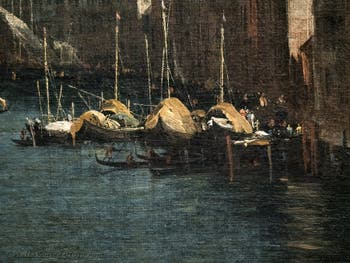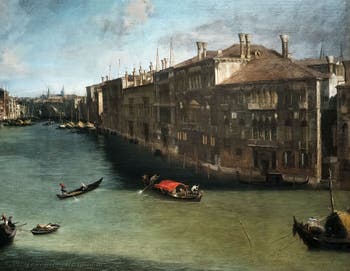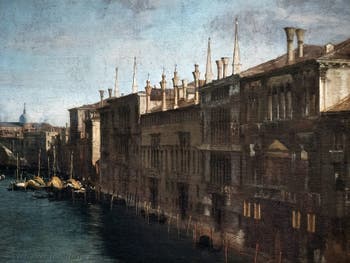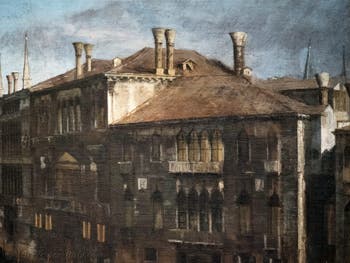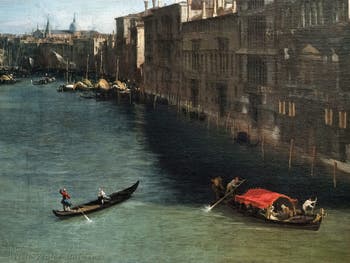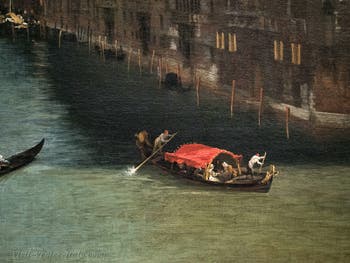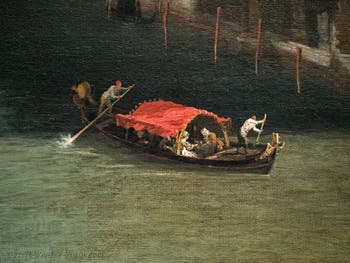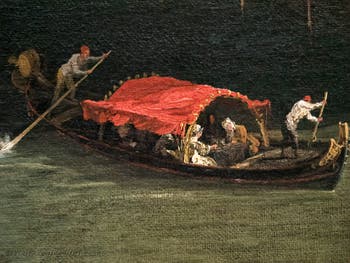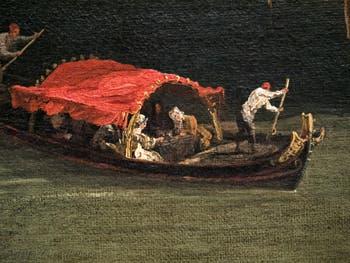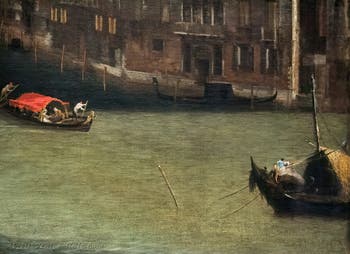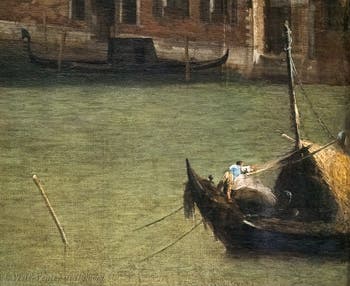Art Painters | Music | Literature | Video | Pictures
Painters Tintoretto | Titian | Canaletto | Fortuny | Albrecht Dürer |
Canaletto Life and Career | Paintings
Paintings Grand Canal Balbi | Grand Canal Foscari | Rialto Bridge | Mendicanti | Saint-Mark | Piazzetta | Rome
Canaletto “Venice Grand Canal from Balbi Palace to Rialto Bridge”
Painting - Oil on Canvas (144 x 207cm) 1723 - Ca' Rezzonico Palace Venice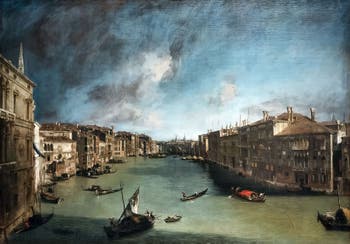
Canaletto Venice Grand Canal from Balbi Here Canaletto takes us as the crow flies along the Grand Canal of Venice, from the Ca' Foscari Palace windows to the Rialto Bridge.
Canaletto brings the distance closer in his perspectives.
His personal way of rendering perspective is already present in this youth painting since he is only 25 years old.
While in its predecessors, perspective serves to create a vanishing point, to make the eye lost in the distance, Canaletto totally reverses this effect.
The farthest part of the landscape does not “run away”; it is approaching!
The depth of the landscape is still present, but the eye can embrace the whole without “slipping” along the facades to reach the end of the painting.
Perspectives are respected; the farthest palaces are, as they should be, smaller, but “they do not move away”!
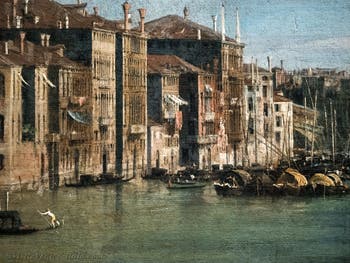
Canaletto Venice Grand Canal from Balbi It seems simple to us, but for the time, it was a true pictorial revolution.
To get there, Canaletto uses light in part.
All these parts of facades lit by the sun are “hanging”, “linked” to the foreground of the painting.
It is the same white that is found in the sail of the boat that occupies the centre, in the foreground, as on the facade of the palace, which is just to the left of the Rialto Bridge, or in the canvas that covers the deck of the boat which is moored at the bottom, under the dome of the Basilica of San Giovanni e Paolo, to the right of the Rialto.
It is always the same white found in the foam of the oars of the boats of the second plane and in the clothes of the gondolier to the left in the fourth plane.
The chimneys, the mooring piles, the awnings of the facades, the obelisks at the top of the Palazzo Papadopoli (on the left), all contribute together to strengthen this feat of strength of Canaletto, which thus succeeds in bringing together, moving towards us all the elements of the distant.
Sky and Water of the Grand Canal of Venice
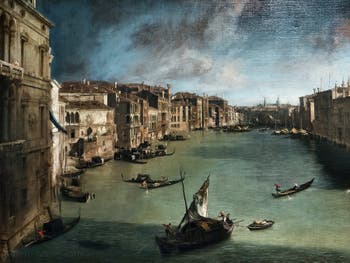
Canaletto Venice Grand Canal from Balbi The same effect appears in the sky where the clouds do not move away; they come to us.
Finally, by shadows and effects of water transparency, by the angles drawn by the various positions of the boats, the Grand Canal "spreads" without getting lost in the distance.
This prevented him from falling into the mistake of presenting a Grand Canal that “climbs”, as seen in some paintings by other painters.
This is one of the simple tests to distinguish great painters from others.
When the sea or water “rises” by forming a wall in a painting, instead of moving away towards the horizon, it can be considered that its author is of average quality!
The Facades of the Palaces along the Grand Canal
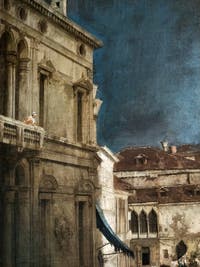
Grand Canal from Balbi On the left, we see a part of the facade of Palazzo Balbi with a Venetian shawl, leaning to her balcony, watching the show of the boats just below it.
This facade is beautifully treated with effects of shadow and light, with highly drawn architectural elements.
Others are rendered in a more blurred way to create the impression of relief and put even more forward this balcony and its Venetian.
A facade “underlined” by the bright whiteness of the front of Palazzo Caortorta Angaran located just to its right.
The Venetian woman on her balcony is sketched in just a few very simple and yet exact brush strokes.
We see the fringes of his shawl protruding from the balcony railing; we distinguish his eyes and the black headband that holds his headdress.
It is hardly drawn, but the use of colours, unique in this part of the painting, and the light that comes out of it, immediately make it the main point of this part of the painting.
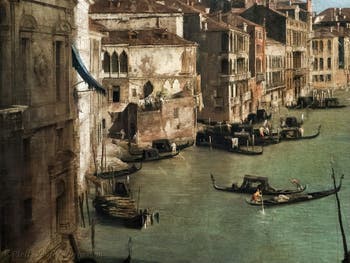
Canaletto Venice Grand Canal from Balbi Several gondolas are moored in the following stall between the Palaces Dandolo and Dolfin, where the San Tomà stop of the Water bus station is now located.
Further on, to the left of Palazzo Papadopoli, we see a palace that no longer exists today; it has been replaced by the garden adjacent to the Papadopoli Palace.
It is also interesting to see the laundry that dries on the facades of the Palaces of the Grand Canal, which is absolutely forbidden today by the municipality so as not to “spoil” the decor!
The whole right part is in the shade, heavily faded, but Canaletto still succeeds in bringing it to life with some sunbathed stall, sunbathing fireplaces and a few boats wisely placed along the shore.
This treatment of the facades of the right bank in the shade also brings a touch of melancholy and poetry to the whole.
Gondolas and Boats on the Venice Grand Canal
Most gondolas are “closed” by a “felze”: we could still see “felzi” installed on the gondolas until around 1950.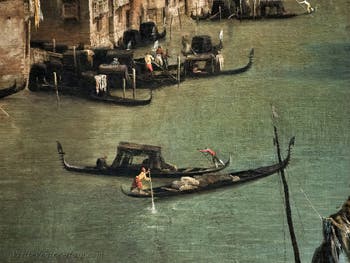
Canaletto Venice Grand Canal from Balbi The “Felze” was a cabin fixed in the middle of the gondola, which allowed its occupants to protect themselves from the rain or the sun and, incidentally, to offer them some privacy or even the incognito.
Some details of this painting clearly show that Canaletto was indeed a child of Venice.
Indeed, the position of the two intersecting gondoliers exactly corresponds to the efforts provided by each of them.
Whoever is in yellow and red pushes a gondola without “Felze” heavily loaded with bags of goods, heavily arched, it grows significantly more difficult on his oar than the other.
This effort can be seen even in the foam produced by the entry of the oar into the water.
There is a small scene of everyday life on the dock, a dialogue between those on the shore and the passengers of the first gondola, while a small dog leaps in front of the beggar leaning against the wall.
All large transport boats are moored and covered. Workers have already returned home!
Only gondolas and a few smaller transport boats are still active on the Grand Canal.
Breakthrough of the sun to the right of Palazzo Foscari
In this painting, the sun pierces the water of the Grand Canal from the Accademia Bridge (which did not exist at the time) to the level of San Tomà.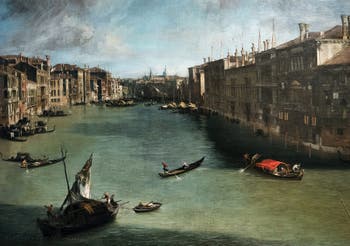
Canaletto Venice Grand Canal from Balbi This breakthrough of light alone creates a foreground underlined by the different colours and lighting of the water; it is amplified by a few touches of light in the sails and clothes of the characters, not to mention the bright red boat!
This boat is a “Peata” with two rowers, relatively large and covered with a red canopy enhanced with golden elements.
A long table is installed under the canopy, and passengers sit on either side of the table.
A boat heavily loaded with passengers, given its relatively low water line on the water, and especially wide.
At first glance, they are at least eight, hence the effort of the "Popier" (the stern rower in Venetian) to advance and direct his boat.
Finally, on the boat on the right in the foreground, a sailor finishes storing his boat docked in order after his working day.
An element particularly well treated by Canaletto, we “see” the move of the sailor, we “attend” the show.
Paintings Grand Canal Balbi | Grand Canal Foscari | Rialto Bridge | Mendicanti | Saint-Mark | Piazzetta | Rome
Canaletto Life and Career | Paintings
Painters Tintoretto | Titian | Canaletto | Fortuny | Albrecht Dürer |
Art Painters | Music | Literature | Video | Pictures
Back to Top of Page


